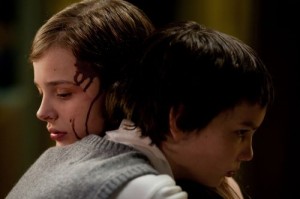Tomas Alfredson’s Let the Right One In was one of my favorite films of 2008. It was atmospheric, moody, complex, metaphorical, and romantic in the strangest possible way. I loved that it raised some interesting questions about what it would mean to fall in love with a vampire who will always be 12, how that love would change as one partner aged noticeably. I enjoyed thinking about what it would mean that the vampire looked like a twelve year old, but was in fact much older than that; if that’s the case and this is a vampire that lures 12 year old boys into being her protector and (presumably) lover, then doesn’t that make this vampire a pedophile?
The point is that it was a film that dealt with complexities we would never find in an American film, right?
The remake, entitled Let Me In, surprised me in how faithful it remained to the Swedish original. I would say that it remained true to the mood and atmosphere of the first film while adding some interesting wrinkles here and there as well as making some improvements. One noticeable improvement is that writer/director Matt Reeves excised the subplot with the nosy neighbor who is transformed into a vampire. He manages to keep the iconic image of the woman bursting into flames in her hospital room, but we don’t have to deal with her whole boring back-story.
I also think that Reeves chose two skilled actors in Chloe Moretz (as Abby) and Kodi Smit-McPhee (as Owen), actors who I think help the audience sympathize with them more. The basic outline of their “love” story is intact, but my perception of it changed slightly. I was much more aware of the romantic nature of the film in this version and the ways in which Owen cares for Abby and vice versa. Owen, especially, is almost comic in his empathy. When Abby vomits after trying a Now & Later, Owen’s first reaction is to hug her tightly. It’s a heartwarming moment. Abby, of course, cares very much for Owen, perfectly expressed in the climactic pool scene (more on that later). The way in which she cares for Owen reminded me a bit of the way Adam Sandler’s character expresses his love for Emily Watson in Punch-Drunk Love. When there is an boiling rage inside of you, but you want to express your love, sometimes your love is not expressed in the things you say or do, but in the way you protect someone with your rage. I think that’s the point of Abby and Owen’s love affair, they express their affection in different ways, but they can both recognize that it’s affection regardless.
Another reason that I responded strongly to this film is something my viewing companion brought up. She said there was something about hearing the dialogue in our own language that made the film more effective. I thought it was an interesting point. I love foreign films, love reading subtitles, but there indeed is a difference between hearing words actually spoken than reading them as they are being spoken in a foreign tongue. Not only that, I was better able to appreciate the sense of foreboding and terror because I didn’t have to worry about missing a line of dialogue.
I really have nothing but positive things to say about the film since it’s almost exactly like the original (emphasis on ORIGINAL)…except for the pool scene. I think there are a number of things wrong with the scene as presently constituted, including the fact that it seems to all happen much too quickly. But there is one big difference that really kills it aesthetically and that’s that the bullies decide to turn the light off inexplicably. Turning the lights off makes it hard to see what’s happening and we should be seeing absolutely everything. The power of that scene in the original is that we see what the boy doesn’t as he is drowning. But now, we can’t see much. We see enough to know what’s going on – including a severed head – but it doesn’t have the same impact or the same beauty as the original version of that scene did. It let me down a bit.
I’m also of two minds when it comes to a shot that Reeves inserts of Owen seeing a photo of Abby and the Richard Jenkins/protector character as a young man. It’s implied in the original that the Owen character would now be taking on the “protector” role, but here it’s completely spelled out for us.
Ultimately, I’m not unhappy that the film was made, but I’m not sure it was necessary either. I think the first version is a superior product, despite whatever flaws it might have, but in the end I guess I can’t argue with remaking the film the way it was remade. If nothing else, people who won’t go to films with subtitles will now have a chance to see this story told and told in a similar fashion.
But I think if you’ve seen the original, there’s not really a pressing need for you to see the remake.










